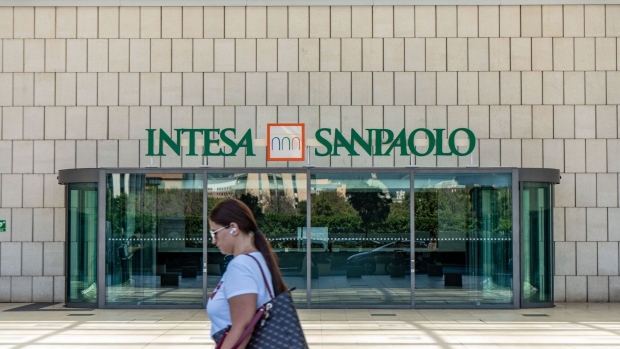Aug 18, 2023
Intesa to Consider Small Deals to Boost its Presence Abroad
, Bloomberg News

(Bloomberg) -- Intesa Sanpaolo SpA, Italy’s biggest lender, may consider smaller-scale acquisitions in European regions where it operates and in key Mediterranean rim countries to strengthen some of its core activities.
“While we are focusing on organic growth, the bank is ready to catch any external growth opportunities that could arise,” Marco Elio Rottigni, chief of Intesa’s International Subsidiary Banks Division unit, said in an interview at company headquarters in Milan. “An acquisition should bring synergies, fit with our business model and be done at the right value — conditions that we don’t see at the moment.”
The interview was done shortly before Italy’s government surprised markets with an unexpected levy on banks’ windfall profits that may cost lenders as much as €3 billion ($3.3 billion) in additional taxes. Asked about its impact in a follow up, Rottigni confirmed that the division’s strategy remains unchanged.
Rottigni’s unit is seeking to increase its share in foreign markets where it’s already present, by expanding investment banking and global markets activities and reinforcing wealth management, private banking and insurance businesses. The lender may also move to buy loans or mortgage portfolios to expand the business, he said.
“We want to be stronger in central and eastern European countries where we are already strong,” Rottigni said. “We could also consider expanding in some of the Mediterranean rim countries where Italian companies have strong business relationships, in order to have a gateway to the southern part of the world,” he said, adding that Intesa will continue to focus on supporting Italian companies expanding internationally.
The unit, known as ISBD, operates in three continents through 11 commercial banks across central-eastern Europe and Egypt, and runs a wealth management company in China. It serves 7 million clients through a network of almost 900 branches and about 21,000 employees. Intesa’s Serbian unit is the country’s largest by assets, while its Croatian and Slovak units are the second largest in their respective countries.
In Egypt, where it owns an 80% stake in Alex Bank, Intesa has started preliminary talks with the government for a possible purchase of the remaining stake, which is owned by the state, Rottigni said.
‘New Level’ Profit
ISBD is focusing on technology and digital transformation to help cut costs, increase margins and accelerate the integration of its foreign banks, Rottigni said, adding that he expects improving results at the division, despite a complex economic and geopolitical environment.
“Within the ISBD division, we expect net income this year to reach a whole new level, well above previous years, thanks to balanced growth of loans and deposits and higher core revenue,” Rottigni said. While rising rates have given a boost to income from lending across all European banks, the executive said he sees income from fees as key to revenue growth.
“Fees account for about 20% of the unit’s revenue, and we are working to increase their weight to 30%,” he said. The division’s plans include “pushing on structured finance services and wealth management for the affluent segment through synergies with other group divisions.”
Over the last three years, ISBD has recorded average growth in total assets of 7% per year and in the first half accounted for 17% of Intesa’s profit. Net income in the six months ending in June more than tripled from a year earlier to €679 million, driven by higher operating income and lower provisions for bad loans.
“The Euro-Mediterranean region will play an increasingly central role for global maritime routes,” Rottigni said. “Our presence in the region is supporting the internationalization of Italian companies and contributing to growth in the area.”
©2023 Bloomberg L.P.






